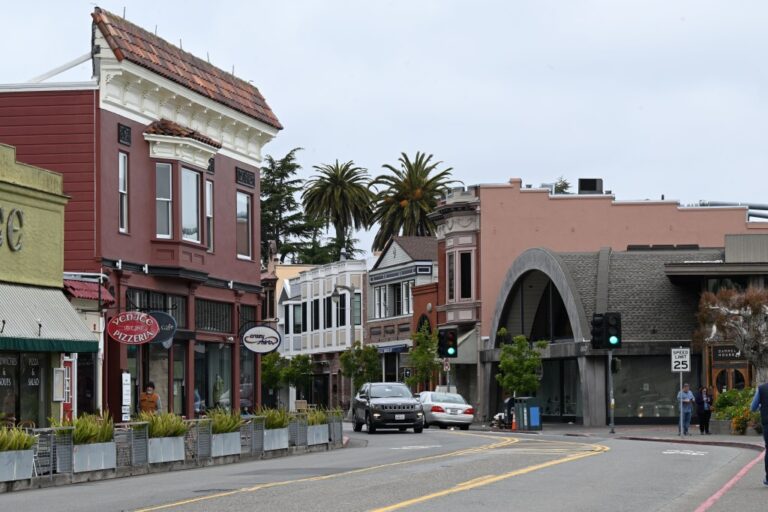Stores line the Bridgeway near the Princess Street intersection on Thursday, May 25, 2023 in Sausalito, California. (Sherry LaVars/Marin Independent Journal)
The Sausalito City Council has approved a draft management plan for the proposed Downtown Business Improvement District.
The plan details the boundaries, budget and benefits of the proposed district, which would fund maintenance of public spaces, branding, improved lighting and parks, and enhanced government services.
The council unanimously passed the draft at Tuesday's meeting.
Mayor Ian Sobieski said: “This will give local residents more control over their area.” “I think this is an exciting new era of doing more with less.”
Business improvement districts provide additional services not provided by municipalities and are funded through annual assessments. These typically give business owners greater autonomy to make aesthetic changes and promote tourism, and are often managed by non-profit stakeholder groups.
In June 2023, the city hired New City America Inc. to conduct a public interest and feasibility study for the new district. In December, the City Council endorsed the proposed district boundaries and budget.
According to the draft plan, Benefit Zone 1 consists of the core commercial area along Bridgeway, where the most retail stores and restaurants are located. Benefit Zone 2 includes the city parking lot on the east side of Bridgeway and Humboldt Street.
The plan sets annual assessed values for buildings at $0.22 per square foot in Zone 1 and $0.10 per square foot in Zone 2 in the first year. For lots, the annual rate is $0.14 per square foot for Zone 1 and $0.26 per square foot for Zone 2. Annual rates for linear frontage are $6 for Zone 1 and $9.30 for Zone 2.
Marco Li Mandri, president of New City America, said that although the district is not very large, there are many public spaces and parks that need special district benefits. He said the general services provided by the city would not be enough and that special perks, such as additional trash removal after events downtown, would be supplemental.
“Property owners clearly want more than what currently exists in the district, and business owners clearly want more,” Lee Mandoli said. “So if someone happens to go to the park and they happen to have ice cream and they spill their ice cream in the summer and it melts all over the place, they don't have to look at it for a week. It will be processed within two days. So these are the special benefits offered.”
Parks and open spaces in the area include Gabrielson Park, Etocchi Park and Viña del Mar Park, said Brandon Phipps, director of the city's Community Development Department.
The first year's property appraisal income is expected to be $241,059. “Demand Creation” is a service category that accounts for 55% of the budget and includes a wide range of needs such as holiday events and decorations, public art displays, lighting, website development, and public relations.
“You can't have parks and public spaces unless they're maintained,” Lee Mandoli said. “The city can do the basics, but what we want to do is enhance the public spaces so that they become great gathering spaces.”
The “Private Sidewalk” service category, which accounts for 15% of the budget, includes not only parking and transportation management, but also the maintenance and aesthetic improvements of public spaces and sidewalks. Administrative and program management, 25% of the budget, covers rent, legal fees, and office-related expenses. The remaining 5% goes toward delinquent payments, city and county fees, reserve funds, and capital project improvements.
The City Council approved the plan with the condition that the infrastructure budget be increased. Address vacancy rates. Includes more wayfinding, lights and trash cans. Protect historic resources. Consider partnering with a chamber of commerce to reduce administrative fees. The district will be based at the Sausalito Arts Center.
The district includes approximately 10 blocks of downtown Sausalito and most of the subdivisions in and around downtown. This includes parcels on both sides of Bridgeway, from both sides of Humboldt Street southward to Tracy Street, and along both sides of Princess Street.
The city, which owns about half of the parcel, is contributing 50% to the district.
The City Council also authorized the city manager to begin the district petition process, which includes finalizing the management plan, engineer's report, and petition language. The items will be mailed to all property owners within the proposed area, according to a staff report.
A public hearing on the district is expected to be held in late May or June. A final decision would require a vote of property owners in the jurisdiction through a petition and voting process.
Scott Thornburgh, chairman of the city's Economic Development Advisory Committee, spoke in support of the district. He said the district has a small budget and needs to take risks to grow.
“In the business world, we talk a lot about testing and learning and failing quickly,” Thornburg said. “But this is a test, and I think that's what excited me the most. We're testing something new, so have the courage to take a little risk and believe in something.” That is necessary.”


